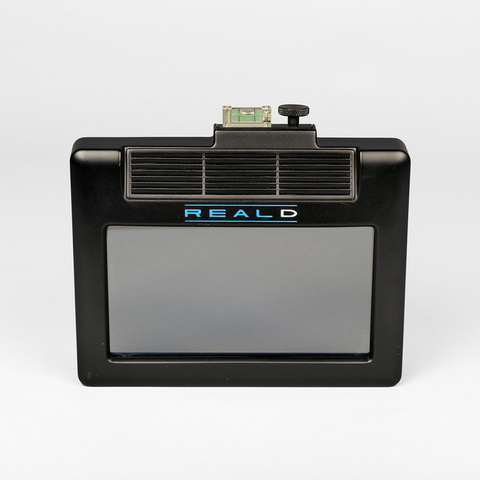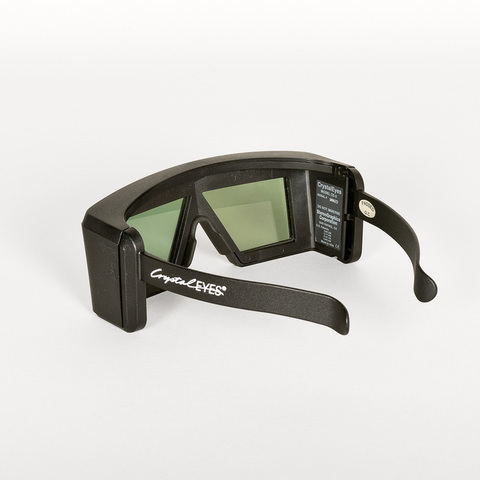Ecran polarisant
Fiche détaillée
Type de l'appareil
écran polarisant système ZScreen Real D pour films 3D et à regarder avec des lunettes polarisantes à cristaux liquides et modulateur ; cadre avec niveau à bulle et vis de serrage
Auteurs
Lipton Lenny
Los Angeles, 8642 Allenwood Road, Californie
Fabricants
RealD Incorporated
Beverly Hills, Californie
Utilisateurs
Lipton Lenny
Los Angeles, 8642 Allenwood Road, Californie
Distributeurs
Informations non disponibles
Sujet du modèle
Informations non disponibles
Objectif
Informations non disponibles
Taille de l'objet
Ouvert :
Informations non disponibles
Fermé :
Longueur : 5 cm
Largeur : 28 cm
Hauteur : 23.5 cm
Diamètre :
Informations non disponibles
Taille de la boîte de transport
Informations non disponibles
Remarques
Marque : "Real D".
Don de Lenny Lipton : "I have the first theatrical ZScreen that was used by Disney. RealD gave it to them so they could screen the work they were doing converting Chicken Little (2005). It may be the first completed ZScreen that was used by the industry but I have no way of knowing for sure. It is a very early unit and it has no serial number" (Lenny Lipton, mail du 19 juillet 2018). Lenny Lipton, inventeur et cinéaste américain (né à Brooklyn, New York, 18 mai 1940), membre de la SMPTE et de la SPIE (International Society of Optics and Photonics), est l'un des fondateurs de la stéréoscopie électronique appliquée au cinéma (système RealD). Il crée la StereoGraphics Corporation en 1980, invente le ZScreen électro-optique modulateur. RealD achète StereoGraphics en 2005, Lenny Lipton devient Chief Technology Officer et perfectionne le système RealD qui est installé dans de nombreux cinémas. Il est l'auteur d'un ouvrage fondamental sur la 3D, Foundations of the Stereoscopic Cinema.
"Il existe trois catégories de variables : le temps, la géométrie et l'éclairage. L'éclairage est la raison pour laquelle l'anaglyphe ne peut pas vraiment marcher, parce que des objectifs de différentes couleurs provoquent un déséquilibre. La géométrie : si une image est plus grosse qu'une autre, vous ne pouvez pas les faire fusionner, etc. Si les champs d'image droit et gauche ne coïncident pas dans certaines limites, les gens ressentent ce qu'ils décrivent comme une fatigue oculaire en regardant des images en 3D. Chez StereoGraphics, j'ai développé des systèmes appliquant ces principes qui pouvaient être utilisés par des scientifiques et des ingénieurs pour créer et visionner des logiciels 3D destinés à des applications diverses, de la cartographie moléculaire au pilotage de la Mars Rover. En 2005, ma société a été acquise par Real D, où j'ai aidé à perfectionné le système de projection Real D pour les films en 3D : un projecteur unique qui alterne images oeil-droit et oeil-gauche au rythme de 144 par seconde, et un modulateur de polarisation qui assure que les champs d'images coïncident dans les limites souhaitées" ("Entretien avec Lenny Lipton, le sorcier de la 3D", Cahiers du cinéma, juillet-août 2009, p. 22-24).
"On November 5, 2005, Chicken Little was released, a film distinguished by two things : it was Disney Animation's first computer generated feature film, and in eighty-four of the 3654 screens on which the film was exhibited in the United States (there were five aditional screens in Canada and Mexico), it was projected stereoscopically, where it did especially well at the box office in its opening weekend, for an average of $ 25 000 versus $ 8650 per screen projected in 35 mm 2-D ; the fact that 3-D tickets cost more was part of the reason for the increased revenue. [...] Disney was the major studio advocate for making the transition to digital distribution, and as part of its strategy to motivate exhibitors to accept digital projection it released Chicken Little, originally produced in 2-D, projected in digital 3-D. The decision to release the film stereoscopically came late, only fourteen weeks before the release date, giving little time to accomplish the conversion to 3-D by Lucas' ILM (Industrial Light and Magic) visual effects house. [...] The decision to release Chicken Little stereoscopically using projectors with the Texas Instruments DMD image engine involved a cooperative effort managed by Disney from their "war room" at the studio, with the help of Dolby providing servers, and RealD, a Beverly Hills company with no track record, providing their electro-optical ZScreen polarisation modulator. [...] The technology that enabled stereoscopic digital depends on the ability to use a single digital projector for a flickerless image using the frame-sequential method, and a selection device, in this case the ZScreen, which provides each eye with only its required perspective view. [...] In the mid-1970s there a handful of experimenters working on field-sequential stereoscopic video displays, which flickered because they ran at 60 Hz, or 30 Hz per eye. Among them were systems demonstrated by Honeywell and also by John A. Roese working for the US Navy, as described in USP 3 903 358, "PLZT Stereoscopic Television System", filed May 22, 1974. I visited Roese in his laboratory in San Diego and came away impressed by the quality of his stereoscopic video images but observed that the 30-fields per second per eye refresh rate produced severe flicker. The improvement that proposed itself was to increase the field rate to 120 Hz so that a 60 Hz image could be seen by each eye. The first lab demonstration of a single display flickerless stereoscopic image took place on November 20, 1981, in Berkeley, California, as I watched stereoscopic images produced by two monochrome closed circuit video cameras displayed on a Conrac monitor. Cameras and monitor had been converted to run at twice the 60 fields per second NTSC rate, 120 fields per second, with the monitor displaying left and right fields that switched between the two cameras. The result was a flickerless 3-D image running at 60 fields per eye per second, observed through ceramic PLZT (lead zirconate titanate) electro-optical shutters mounted in a welder's helmet. The ceramic PLZT electro-optical shutter, invented at the Sandia National Laboratories, was manufactured by both Honeywell and Motorola, and had about a 12% transmission, required more than 200 volts to operate, and were relatively slow, all of which were far from ideal but the best choice for the application in 1981. Our results depended on the fast blanking of television and the modifications to run the video at a high field rate. When one eye saw an image the other saw nothing since the shutters passed and occluded fields out of phase. Each eye's image sequence included a dark period when the shutter was closed, but that was the same thing that happens when looking at a projected 35 mm film. The left and right PLZT shutters opened and closed out of phase with each other and in synchronization with the monitor's video fields as described in USP 4 523 226, "Stereoscopic television system", filed January 19, 1983, by Lipton et al. The principal had been established - it had been demonstrated that a single electronic display could producer flickerless stereoscopic field-sequential images. After years of effort by the company I founded, StereoGraphics Corp., of San Rafael California, the PLZT shutters were superseded by the much brighter and faster pi-cell liquid crystal shutters, requiring low voltage. A special kind of liquid crystal device, the pi-cell, was used for the ZScreen electro-optical modulator that was combined with the field-sequential flickerless technique for stereoscopic imaging. It was first used for molecular modeling computers generated images displayed on cathode ray tube monitors by Evans and Sutherland for their workstation in 1988, and was thereafter applied to video projection often for corporate presentations. The ZScreen was placed in front on the monitor, in close juxtaposition with its screen, and the stereoscopic images were viewed through polarizing eyewear. The technology is described in USP 4 792 850, "Method and System employing a push-pull liquid crystal modulator", filed November 25, 1987, by Lipton et al. The push pi-cell (or surface mode device) technology was originally applied to a communications device as described by its inventor, James Lee Fergason, in USP 4 436 376, "Light modulator, modulator and method of communication employing the same", filed February 17, 1981. [...] It was Ferguson who suggested to me that the technology could be used for stereoscopic image selection, which I applied to both the ZScreen modulator and electronic shuttering eyewear, which were usually used for the direct viewing of a cathode ray tube monitor. The ZScreen electro-optical polarization switch consists of a stack of parts in intimate contact and in optical series : closest to the projection lens is a linear sheet polarizer whose axis bisects the axes of two pi-cells arranged with orthogonally crossed axes. The pi-cells are driven electrically out of phase to switch on and off to alternate between zero and quarter-wave retardation. In this way the linear polarized light introduced by the sheet polarizer is turned into left and right circulary polarized light in synchronization with a frame-sequentially presented train of perspective views. [...] The pi-cell is a liquid crystal version of the Kerr cell, far more comvenient to use and oparating on far lower voltage. [...] The ZScreen located in front of the projector lens is the active component of image selection, which is completed by eyewear fitted with left and right circular sheet polarizer analysers. The ZScreen system of image selection can be explained or classified as using booth polarization and frame sequential occlusion. StereoGraphics Corp. licensed ZScreen technology to RealD in 2004, which acquired Stereographics on March 4, 2005. I joined RealD for four years as its Chief Technology Officer. Combined with the single projector flickerless frame-sequential technology, RealD offered the ZScreen to the theatrical industry for the projection of stereoscopic theatrical films, which was first used for the release of a Disney animated feature, as described above" (Lenny Lipton).
Bibliographie
Lenny Lipton, Foundations of the Stereoscopic Cinema, A Study in Depth, New York, Van Nostrand Reinhold Company, 1982.
Lenny Lipton, "The Stereoscopic Cinema : from Film to Digital Projection", SMPTE Journal, September 2001.
Ray Zone, 3-D Revolution : The History of Modern Stereoscopic Cinema, Lexington, University Press to Kentucky, 2012.
"Entretien avec Lenny Lipton, le sorcier de la 3D", Cahiers du cinéma, juillet-août 2009, p. 22-24.

